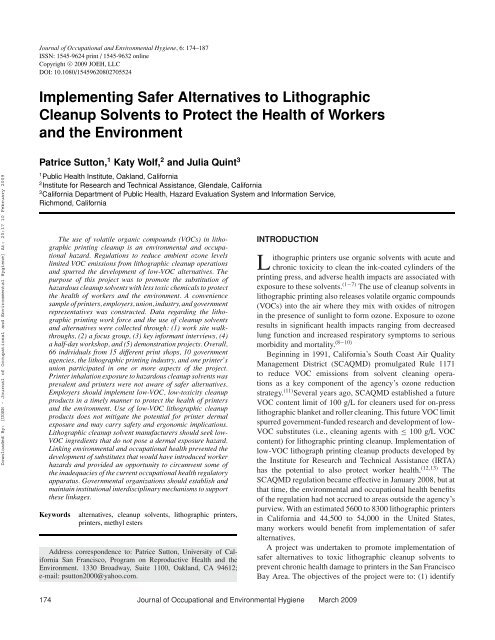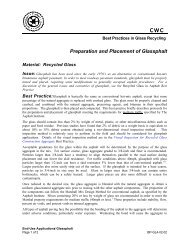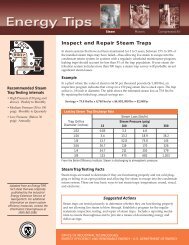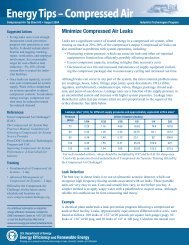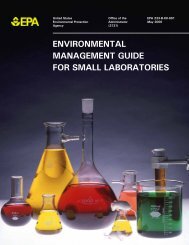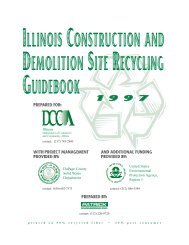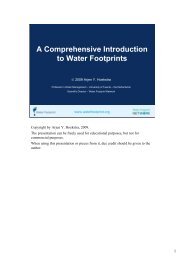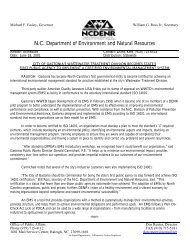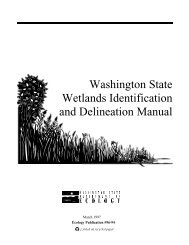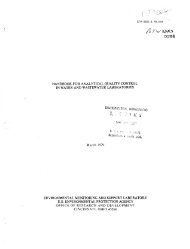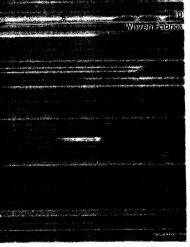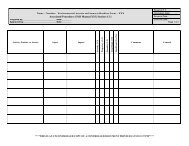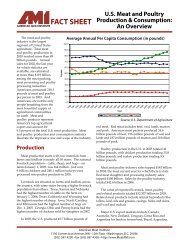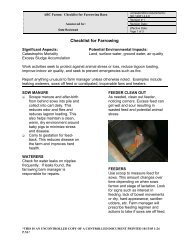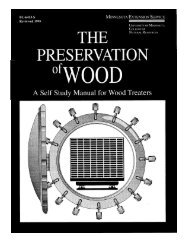Implementing Safer Alternatives to Lithographic Cleanup Solvents to ...
Implementing Safer Alternatives to Lithographic Cleanup Solvents to ...
Implementing Safer Alternatives to Lithographic Cleanup Solvents to ...
You also want an ePaper? Increase the reach of your titles
YUMPU automatically turns print PDFs into web optimized ePapers that Google loves.
Journal of Occupational and Environmental Hygiene, 6:174–187ISSN: 1545-9624 print / 1545-9632 onlineCopyright c○ 2009 JOEH, LLCDOI: 10.1080/15459620802705524<strong>Implementing</strong> <strong>Safer</strong> <strong>Alternatives</strong> <strong>to</strong> <strong>Lithographic</strong><strong>Cleanup</strong> <strong>Solvents</strong> <strong>to</strong> Protect the Health of Workersand the EnvironmentDownloaded By: [UOEH - Journal of Occupational and Environmental Hygiene] At: 20:17 10 February 2009Patrice Sut<strong>to</strong>n, 1 Katy Wolf, 2 and Julia Quint 31 Public Health Institute, Oakland, California2 Institute for Research and Technical Assistance, Glendale, California3 California Department of Public Health, Hazard Evaluation System and Information Service,Richmond, CaliforniaThe use of volatile organic compounds (VOCs) in lithographicprinting cleanup is an environmental and occupationalhazard. Regulations <strong>to</strong> reduce ambient ozone levelslimited VOC emissions from lithographic cleanup operationsand spurred the development of low-VOC alternatives. Thepurpose of this project was <strong>to</strong> promote the substitution ofhazardous cleanup solvents with less <strong>to</strong>xic chemicals <strong>to</strong> protectthe health of workers and the environment. A conveniencesample of printers, employers, union, industry, and governmentrepresentatives was constructed. Data regarding the lithographicprinting work force and the use of cleanup solventsand alternatives were collected through: (1) work site walkthroughs,(2) a focus group, (3) key informant interviews, (4)a half-day workshop, and (5) demonstration projects. Overall,66 individuals from 15 different print shops, 10 governmentagencies, the lithographic printing industry, and one printer’sunion participated in one or more aspects of the project.Printer inhalation exposure <strong>to</strong> hazardous cleanup solvents wasprevalent and printers were not aware of safer alternatives.Employers should implement low-VOC, low-<strong>to</strong>xicity cleanupproducts in a timely manner <strong>to</strong> protect the health of printersand the environment. Use of low-VOC lithographic cleanupproducts does not mitigate the potential for printer dermalexposure and may carry safety and ergonomic implications.<strong>Lithographic</strong> cleanup solvent manufacturers should seek low-VOC ingredients that do not pose a dermal exposure hazard.Linking environmental and occupational health prevented thedevelopment of substitutes that would have introduced workerhazards and provided an opportunity <strong>to</strong> circumvent some ofthe inadequacies of the current occupational health regula<strong>to</strong>ryapparatus. Governmental organizations should establish andmaintain institutional interdisciplinary mechanisms <strong>to</strong> supportthese linkages.Keywordsalternatives, cleanup solvents, lithographic printers,printers, methyl estersAddress correspondence <strong>to</strong>: Patrice Sut<strong>to</strong>n, University of CaliforniaSan Francisco, Program on Reproductive Health and theEnvironment. 1330 Broadway, Suite 1100, Oakland, CA 94612;e-mail: psut<strong>to</strong>n2000@yahoo.com.INTRODUCTION<strong>Lithographic</strong> printers use organic solvents with acute andchronic <strong>to</strong>xicity <strong>to</strong> clean the ink-coated cylinders of theprinting press, and adverse health impacts are associated withexposure <strong>to</strong> these solvents. (1−7) The use of cleanup solvents inlithographic printing also releases volatile organic compounds(VOCs) in<strong>to</strong> the air where they mix with oxides of nitrogenin the presence of sunlight <strong>to</strong> form ozone. Exposure <strong>to</strong> ozoneresults in significant health impacts ranging from decreasedlung function and increased respira<strong>to</strong>ry symp<strong>to</strong>ms <strong>to</strong> seriousmorbidity and mortality. (8−10)Beginning in 1991, California’s South Coast Air QualityManagement District (SCAQMD) promulgated Rule 1171<strong>to</strong> reduce VOC emissions from solvent cleaning operationsas a key component of the agency’s ozone reductionstrategy. (11) Several years ago, SCAQMD established a futureVOC content limit of 100 g/L for cleaners used for on-presslithographic blanket and roller cleaning. This future VOC limitspurred government-funded research and development of low-VOC substitutes (i.e., cleaning agents with ≤ 100 g/L VOCcontent) for lithographic printing cleanup. Implementation oflow-VOC lithograph printing cleanup products developed bythe Institute for Research and Technical Assistance (IRTA)has the potential <strong>to</strong> also protect worker health. (12,13) TheSCAQMD regulation became effective in January 2008, but atthat time, the environmental and occupational health benefitsof the regulation had not accrued <strong>to</strong> areas outside the agency’spurview. With an estimated 5600 <strong>to</strong> 8300 lithographic printersin California and 44,500 <strong>to</strong> 54,000 in the United States,many workers would benefit from implementation of saferalternatives.A project was undertaken <strong>to</strong> promote implementation ofsafer alternatives <strong>to</strong> <strong>to</strong>xic lithographic cleanup solvents <strong>to</strong>prevent chronic health damage <strong>to</strong> printers in the San FranciscoBay Area. The objectives of the project were <strong>to</strong>: (1) identify174 Journal of Occupational and Environmental Hygiene March 2009
Downloaded By: [UOEH - Journal of Occupational and Environmental Hygiene] At: 20:17 10 February 2009lithographic printers potentially at risk for solvent-relatedhealth problems; (2) evaluate solvents used by the printers,including hazard controls and knowledge of the health hazards;(3) identify existing less <strong>to</strong>xic solvent alternatives; and (4)elucidate opportunities and barriers related <strong>to</strong> using safersolvent alternatives in lithographic printing facilities.METHODSSelection CriteriaA convenience sample of printers, employers, union, industry,and government representatives was constructed asfollows: (1) the executive direc<strong>to</strong>r of IRTA (KW) invited participationfrom print shop employers she had worked with in theSCAQMD alternative cleanup solvent technology assessment;(2) based on the experience of the researchers, a short lis<strong>to</strong>f individuals with relevant knowledge of the lithographicprinting industry (i.e., key informants) was developed, andin turn, these initial contacts were asked <strong>to</strong> suggest otherinterviewees; (3) a union representative was asked <strong>to</strong> recruitprinters for a focus group; (4) the collaboration of two localgovernment Green Business Coordina<strong>to</strong>rs was sought; and (5)an invitation <strong>to</strong> a workshop was mailed <strong>to</strong> 173 lithographicprint shops listed by the Bay Area Air Quality ManagementDistrict, the City and County of San Francisco, and AlamedaCounty.Data CollectionData regarding the lithographic printing work force and theuse of cleanup solvents and alternatives were collected betweenAugust 2006 and March 2007 by a variety of methods:Work Site Walk-Throughs of <strong>Lithographic</strong> Print ShopsAn industrial hygienist walked through the printing facilityand directly observed the type and quantity of cleanup solventsin use and the presence and use of exposure control measures.At three facilities, the California Department of Public HealthHazard Evaluation System and Information Service’s (HESIS)<strong>to</strong>xicologist also observed the work process. Using a detailedindustrial hygiene checklist, employer representatives andprinters were queried about the work process, job tasks,cleanup solvent use, exposure control measures, and theemployer’s health and safety program.Focus GroupA focus group of lithographic printers was organized bya union representative and held at the union’s office. Over aperiod of 4 hours, the HESIS <strong>to</strong>xicologist discussed the healtheffects of the cleanup solvents currently in use at the printers’shops, printers were asked <strong>to</strong> respond <strong>to</strong> 15 questions related <strong>to</strong>their use of cleanup solvents, and an industrial hygienist <strong>to</strong>okwritten notes of their responses.Key Informant InterviewA loosely structured conversation by phone or in personwas conducted <strong>to</strong> elicit interviewees’ knowledge of the issue ofcleanup solvent use in lithographic printing and opportunitiesand obstacles <strong>to</strong> implementing safer alternatives.WorkshopA half-day interactive workshop was conducted on saferalternatives <strong>to</strong> printing cleanup solvents in collaboration withlocal, state, and federal government agencies and a union.An industrial hygienist <strong>to</strong>ok written notes of the discussionsections of the workshop.Participation in the project was voluntary. The study pro<strong>to</strong>colswere reviewed by the University of California BerkeleyCommittee for Protection of Human Subjects, which foundthem <strong>to</strong> be exempted provided the information obtained wouldbe recorded in such a manner that subjects could not beidentified directly or through identifiers linked <strong>to</strong> the subjects,or, that the information obtained was publicly available.All data on efficacy (i.e., whether a cleaning agent effectivelycleaned the ink from the rollers or the blankets in areasonable period of time <strong>to</strong> the satisfaction of print shoppersonnel) and environmental and occupational health impactsof safer alternative cleanup products were compiled from theSCAQMD technology assessment previously conducted by theIRTA. (12,13)Data AnalysisFor each cleanup solvent product identified, the materialsafety data sheet (MSDS) was reviewed by the HESIS <strong>to</strong>xicologist<strong>to</strong> determine the identity (Chemical Abstract Service[CAS] number) and the percentage by weight of each of theproduct’s chemical constituents. All workplace, focus group,key informant, and workshop information was compiled andsummarized using descriptive statistics.Evaluation CriteriaWorker exposure <strong>to</strong> cleanup solvents was qualitatively assessedby the industrial hygienist by considering the followingcriteria: (1) the potential for one or more routes of workerexposure; (2) the presence, use, and efficacy of measures <strong>to</strong>limit worker exposure; and (3) the presence of worker trainingand hazard communication about cleanup solvent exposure.The potential occupational health impacts of cleanup solventexposure were assessed by the <strong>to</strong>xicologist by comparing eachof the product’s constituents as listed on its MSDS with itsacute and chronic health effects as described in the scientificliterature. The environmental health impact of the productsevaluated was assessed by comparing the VOC content withthe 100 g/L criteria established by SCAQMD’s Rule 1171.In addition <strong>to</strong> <strong>to</strong>xicity and VOC content, alternative cleanupsolvents were previously evaluated as part of the SCAQMDtechnology assessment by a chemist and one or more printersbased on performance, press compatibility, and cost. (12,13)Journal of Occupational and Environmental Hygiene March 2009 175
Downloaded By: [UOEH - Journal of Occupational and Environmental Hygiene] At: 20:17 10 February 2009RESULTSData CollectionOverall, 66 individuals from 15 different print shops,10 government agencies, the lithographic printing industry,and one printer’s union participated in one or moreaspects of the project. Data were gathered from: five onsiteworkplace walk-throughs involving 13 printers and/oremployer representatives; one focus group with five printersfrom three shops ranging in size from six <strong>to</strong> 35 employeesand one union representative; and 12 key informantinterviews with representatives of government agencies (N= 9), a union, the printing industry, and a printer; and a<strong>to</strong>tal of 48 workshop participants including 25 individualsrepresenting government agencies (1 federal, 4 state, and 5local agencies), 16 printers from 10 shops, five environmentalcompliance consultants, managers, or human resourcespersonnel, a union representative, and a printing industryrepresentative.Workplace ObservationsThe five print shops observed ranged in size from 6 <strong>to</strong>157 printers and had a variety of web and sheet-fed presses(Table I). Two print shops had been previous participants inthe SCAQMD technology assessment; two were recruited afterthey participated in the focus group, and one was invited <strong>to</strong>participate by the San Francisco Public Health DepartmentGreen Business Coordina<strong>to</strong>r. Printers at all of the shops cleanedthe presses’ blankets and rollers by hand either exclusivelyor as a supplement <strong>to</strong> au<strong>to</strong>mated wash systems. To clean theblankets by hand, printers applied the solvent <strong>to</strong> a wipe clothand wiped it across the blanket <strong>to</strong> remove the ink. Printershand cleaned the ink roller train by holding a squeeze bottleabove the rollers and dispensing the cleaner in a stream acrossthe length of the <strong>to</strong>p roller, and then applying pressure <strong>to</strong> therollers with a squeegee or cloth. An ink tray lined with a wipecloth was placed at the bot<strong>to</strong>m of the roller train <strong>to</strong> catch thesolvent/ink combination after it passed through the train. Usedsolvent-soaked cloths were s<strong>to</strong>red in containers with lids andsent <strong>to</strong> a commercial laundry for washing.The three print shops that provided quantitative data usedfrom 0.7 <strong>to</strong> 36 gallons of cleanup solvents daily. Printerscleaned the presses on an intermittent basis throughout theday. Each cleanup generally <strong>to</strong>ok a few minutes. At one shop, amore thorough press cleanup reportedly conducted on a weeklybasis was observed <strong>to</strong> last over an hour. Three shops estimateda printer’s direct exposure <strong>to</strong> cleanup solvents <strong>to</strong>taled fromone-half <strong>to</strong> two hours a day. Nitrile gloves were available forcleaning the press in all five shops; hand cleaning without theuse of gloves was observed at one shop. None of the print shopsroutinely used local exhaust ventilation or respira<strong>to</strong>ry or eyeprotection while handling cleanup solvents. The two smallershops (< 35 employees) also had no mechanical dilutionventilation systems.Health Impacts of Chemicals in <strong>Cleanup</strong> <strong>Solvents</strong>A <strong>to</strong>tal of 20 MSDSs for high-VOC cleanup products wereobtained as follows: 7 were provided by four of six printshops participating in the workplace walkthrough and/or focusgroup, and 13 had been obtained by IRTA from print shops thatparticipated in the SCAQMD technology assessment (Table II).The MSDSs for the 20 products included 31 hazardousingredients, and the majority of products (15 of 20) containedmore than 60% organic solvents (Table III). Thirteen cleanupproducts contained one or more chemicals with recognizedchronic health impacts beyond general solvent <strong>to</strong>xicity, includingcancer, blood abnormalities, asthmatic bronchitis, peripheralnerve damage, and reproductive/developmental effects,and 10 products contained chemicals with “skin notations”(Table II).Health Impacts of Chemicals in Alternative ProductsMSDSs for 14 alternative low-VOC cleanup productswere previously identified and evaluated in the SCAQMDtechnology assessment (Table IV). The MSDSs for the 14products included 20 hazardous ingredients (Table V). Of 14alternative cleaners, 4 had no hazardous ingredients listed onthe MSDSs, 4 were formulated from fatty acid esters andsurfactants alone or in combination, and 6 from one or moreorganic solvents (Table IV).Focus GroupAll five printers shared a general recognition that use ofcleanup solvents could impact their health and a concernabout the damage that may have already accrued from theirchronic exposures. Cancer and reproductive health hazardswere specific concerns. None of the printers was aware of theexistence of safer alternatives, and all reported receiving sometraining about chemical hazards.Demonstration ProjectTwo print shops, one large and one small, had expressedinterest in converting <strong>to</strong> safer alternatives and both were invited<strong>to</strong> participate in a demonstration project conducted by IRTA’sexecutive direc<strong>to</strong>r.At the small shop, soy- and ace<strong>to</strong>ne-based alternativecleanup products were manually tested on two sheet-fedpresses. Soy Gold 2500 followed by a plain water rinse wastested as a roller wash, and Rho-Solv 7248 was tested asa blanket wash. To prevent a fire hazard, manufacturers ofau<strong>to</strong>mated blanket and roller wash systems recommend usingmaterials with a flash point of 140 ◦ Forgreater. Based on itsflash point, the soy product was suitable for au<strong>to</strong>mated systems,but the ace<strong>to</strong>ne-based product was not. Both alternativestested met the performance expectations of the printers. Twoshopwide conversion scenarios were calculated based onthe volume of blanket and roller cleanup solvents currentlypurchased and the fact that the soy but not the ace<strong>to</strong>ne productcould be used in au<strong>to</strong>mated systems. The cost analysis assumedthat converting <strong>to</strong> alternatives would require the same amoun<strong>to</strong>f product and labor as the cleanup solvents currently in use.176 Journal of Occupational and Environmental Hygiene March 2009
TABLE II.Hazardous Ingredients in <strong>Lithographic</strong> <strong>Cleanup</strong> Products by Product (N=20 products)Product andManufacturer(MSDS Date) Chemical Concentration % (w/w) CAS No. Additional Health Effects ADownloaded By: [UOEH - Journal of Occupational and Environmental Hygiene] At: 20:17 10 February 20091 Super Clean BW(3/11/01)Super Chem Corp.,Anaheim, CA2 Pressroom SolutionsBlanket & RollerWash 5001-5(3/9/00)PressroomSolutions, FortWorth, TX3 ICALL PRO(11/18/01)IC CompoundCompany,Gardena, CA4 LC-1700 Press Wash(8/03)Litho-Chem, Inc.,Sante Fe Springs,CA5 AQ 1301 RollerWash No. 1(10/02)Litho-Chem, Inc.,Sante Fe Springs,CA6 AQ1302 RollerWash No.2 (10/98)Litho-Chem, Inc.,Sante Fe Springs,CA7 PowerKlene VCBlanket and RollerWash (6/10/97)Printers’ ServiceNewark, NJEthylphenoxypolyethoxy-ethanolNot given 9036-19-5D-Limonene Not given 5989-27-5 Skin irritation and allergiccontact dermatitis (14−16)Aromatic hydrocarbons 10–15 64742-95-61,2,4-Trimethyl benzene 3–5 95-63-6 Blood abnormalities/asthmatic bronchitis (17,18)Aliphatic hydrocarbons 85–90 64742-88-7Mineral spirits Not given 64742-88-7Aromatic hydrocarbondistillatesNot given 6472-95-62-Propoxy ethanol Not given 2807-30-9 Blood abnormalities (19)2-Propanone 1–10 67-64-1Aliphatic hydrocarbon >60 6742-89-8Aliphatic hydrocarbon 30–60 8008-20-6Aromatic hydrocarbon 10–30 64742-95-6Glycol ether B 1–10 111-76-2 Blood abnormalities (19)Aliphatic hydrocarbon 70–80 8052-41-3Aromatic hydrocarbon 15–25 64742-95-6Glycol ether B 7–12 111-76-2 Blood abnormalities (19)Aromatic petroleum40–50 64742-95-6distillate (C8-C12)Aliphatic petroleum40–50 64742-46-9distillate (C9–C11)Diproplyene glycol methyl1–10 34590-94-8ether B(+)-4-Isopropenyl-1-1–10 5989-27-5methylcyclohexeneSorbitan monoleate 1–10 1338-43-8(Continued on next page)178 Journal of Occupational and Environmental Hygiene March 2009
TABLE II.Hazardous Ingredients in <strong>Lithographic</strong> <strong>Cleanup</strong> Products by Product (N=20 products)(Continued)Downloaded By: [UOEH - Journal of Occupational and Environmental Hygiene] At: 20:17 10 February 20098 Hydro Clean WaterActivated PressCleaner (8/1/98)Lee Chemical Co.,Los Angeles, CA9 Low VOC 1.68Blanket Wash(8/10/96)A.G. Layne Inc.,Los Angeles, CA10 Blanket Wash(2/20/03)Bay InternationalChemicalProducts,Addison, IL11 Allied Hydrowash(8/22/96)Allied Pho<strong>to</strong> OffsetSupply Corp.,Hollywood, FL12 Anchor Envirowash220 (3/14/03)Anchor Lithkemko,Orange Park, FLMineral spirits Not given 64742-47-8Hydrotreated Not given 8052-41-3distillate, lightXylene Not given 1330-20-71,3,5-Trimethyl Not given 108-67-8benzene1,2,4-TrimethylbenzeneNot given 95-63-6 Blood abnormalities/asthmaticbronchitis (17,18)Isopropylbenzene B Not given 98-82-8Ace<strong>to</strong>ne Not given 67-64-1Solvent naptha, light Not given 64742-89-8aliphaticXylene Not given 1330-20-71,2,4-TrimethylbenzeneNot given 95-63-6 Blood abnormalities/asthmaticbronchitis (17,18)Solvent naptha, lightaromaticNot given 64742-95-6Petroleum naptha 53 64742-47-8Petroleum naptha 28 64742-95-61,2,4-Trimethylbenzene11 95-63-6 Blood abnormalities/asthmaticbronchitis (17,18)Dipropylene glycol 3 34590-94-8methyl ether BXylene 1 1330-20-7Aromatic petroleum 50 64742-95-6distillatesXylene 2–5 1330-20-7Cumene B 1–4 98-82-81,2,4-Trimethylbenzene24–29 95-63-6 Blood abnormalities/asthmaticbronchitis (17,18)Aliphatic petroleumdistillates46 64741-41-9Aliphatic10–20 64742-88-7hydrocarbonAromatic5–10 7069306-0hydrocarbonsFatty acid ester 15–30 not clear, number provided yielded no resultsTSRN 06-0836-331-5005Aliphatic50–70 64741-47-5hydrocarbon(Continued on next page)Journal of Occupational and Environmental Hygiene March 2009 179
TABLE II.Hazardous Ingredients in <strong>Lithographic</strong> <strong>Cleanup</strong> Products by Product (N=20 products)(Continued)Downloaded By: [UOEH - Journal of Occupational and Environmental Hygiene] At: 20:17 10 February 200913 Shell Mineral Spirits 146 HT (1/21/90) Mineral spirits 100 64742-88-7Shell Oil Co., Hous<strong>to</strong>n, TX14 Wash A-230 (2/1/00) Petroleum naphtha 90 64742-88-7Varn Products, Addison, IL Petroleum naphtha 5 64742-95-61,2,4-Trimethylbenzene2 95-63-6 Blood abnormalities/asthmaticbronchitis (17,18)15 Wash V-120 (2/1/00) Petroleum naphtha 43 64742-88-7Varn Products, Addison, IL Petroleum naphtha 32 64742-95-61,2,4-Trimethylbenzene12 95-63-6 Blood abnormalities/asthmaticbronchitis (17,18)Dipropylene glycol 6 34590-94-8methyl ether B1,8(9)-p-Methadiene 2 5989-27-5Xylenes 1 1330-20-716 Type Wash (2/1/00) Toluene B 54 108-88-3 Developmentaleffects (20)Varn Products, Addison, ILn-Hexane and mixed 21 110-54-3 Peripheral nerveisomers B damage (7)Isopropanol 25 67-63-017 V-1106 Rejuvena<strong>to</strong>r Plus (10/23/98) Petroleum naptha 35 8032-32-4Varn Products, Addison, IL Diace<strong>to</strong>ne alcohol 5 123-42-2Propylene glycol 5 57018-52-7 Cancer (20)t-butyl etherToluene B 5 108-88-3 Developmentaleffects (20)Isopropanol
TABLE III.Hazardous Ingredients in <strong>Lithographic</strong> <strong>Cleanup</strong> Products by Chemical (N=31 chemicals)HazardousIngredientsChemical AbstractNumber (CAS #)Number of Productswith CAS #Concentration% (w/w)Downloaded By: [UOEH - Journal of Occupational and Environmental Hygiene] At: 20:17 10 February 20091 Aromatic hydrocarbons 64742-95-6 10 Not given <strong>to</strong> 502 1,2,4-Trimethyl benzene 95-63-6 7 Not given <strong>to</strong> 293 Aliphatic hydrocarbons 64742-88-7 6 Not given <strong>to</strong>1004 Xylene 1330-20-7 4 Not given <strong>to</strong> 55 2-Bu<strong>to</strong>xyethanol (ethylene glycol 111-76-2 3 1–60monobutyl ether) A6 Diproplyene glycol methyl ether A 34590-94-8 3 1–107 D-Limonene 5989-27-5 3 Not given <strong>to</strong> 108 Mineral spirits 64742-47-8 3 Not given <strong>to</strong> 599 Toluene A 108-88-3 2 5–5410 Solvent naptha, light aliphatic 64742-89-8 2 Not given <strong>to</strong> 10011 Isopropanol 67-63-0 2 < 5–2512 Ace<strong>to</strong>ne 67-64-1 2 Not given <strong>to</strong> 1013 Aliphatic hydrocarbon 8052-41-3 2 Not given <strong>to</strong> 8014 Cumene A 98-82-8 2 Not given <strong>to</strong> 415 n-Hexane and mixed isomers A 110-54-3 1 2116 Diace<strong>to</strong>ne alcohol 123-42-2 1 517 Sorbitan monoleate 1338-43-8 1 1 <strong>to</strong> 1018 2-Propoxy ethanol 2807-30-9 1 Not given19 Propylene glycol t-butyl ether 57018-52-7 1 520 Aliphatic petroleum distillates 64741-41-9 1 4621 Aliphatic hydrocarbon 64741-47-5 1 50–7022 Aliphatic petro distillate (C9–C11) 64742-46-9 1 40–5023 Petroleum naptha 64742-94-5 1 1024 Aliphatic hydrocarbon 6742-89-8 1 > 6025 Aromatic hydrocarbons 70693-06-0 1 5–1026 Dichloromethane (methylene75-09-2 1 45chloride)27 Aliphatic hydrocarbon 8008-20-6 1 30–6028 Petroleum naptha 8032-32-4 1 3529 Ethylphenoxypolyethoxy-ethanol 9036-19-5 1 Not given30 Fatty acid ester TSRN06-0836-331-5005Not clear, numberprovided yielded noresults1 15–3031 1,3,5-Trimethyl benzene 108-67-8 1 Not givenNote: Hazardous ingredients as listed in Section II of product MSDS by name and CAS number. The 20 high-VOC products evaluated contained 31 uniqueCAS numbers and, thus, 31 different chemicals. The duplication and overlap of the names of ingredients listed under the Hazardous Ingredients column, such as“aromatic” and “aliphatic,” reflect the imprecision of how the chemicals were named on the MSDSs.A Skin notation, significant amounts of chemical can be absorbed through the skin and contribute <strong>to</strong> systemic <strong>to</strong>xicity.design of printing presses up <strong>to</strong> the use of cleanup chemicalson the shop floor (Table VI).DISCUSSIONPrinter Exposure <strong>to</strong> <strong>Cleanup</strong> ProductsPrinters participating in this project were exposed on a dailybasis <strong>to</strong> products containing a high concentration of hazardoussolvents (Table II). (7,14−20) At all shops, hand cleaning thepress placed printers’ breathing zones less than an arm’slength away from solvent-soaked cloths in the absence oflocal exhaust ventilation <strong>to</strong> capture the vapors. All printersalso had the potential for skin exposure <strong>to</strong> <strong>to</strong>xic chemicalswhile cleaning the press. For half of the high-VOC products inuse, this hazard was significantly compounded by the capacityof one or more chemical constituents <strong>to</strong> be absorbed throughthe skin in substantial quantities and contribute <strong>to</strong> systemic<strong>to</strong>xicity. Although nitrile gloves were generally reported and/orobserved <strong>to</strong> be available, cleaning without gloves was said <strong>to</strong>routinely occur at one shop and was observed at another.Journal of Occupational and Environmental Hygiene March 2009 181
TABLE IV. Hazardous Ingredients in Alternative Low-VOC (≤ 100 g/L) <strong>Cleanup</strong> Products by Product(N=14 products)Product and Manufacturer(MSDS Date) Hazardous Ingredients (%) CAS No.Downloaded By: [UOEH - Journal of Occupational and Environmental Hygiene] At: 20:17 10 February 20091 SOYGOLD 2500 Rinseable Solvent(2/4/05) AG Environmental Products,LLC, Omaha, NE2 Metalnox M6521 (8/20/04)Kyzen Corporation, Nashville, TN3 Mirachem Pressroom Cleaner 2501(7/3/96)Mirachem Corp., Tempe, AZ4 Mirachem Experimental CommercialPrinting Cleaner NP 2520 (8/31/04)Mirachem Corp., Tempe, AZ5 Magic Wash 522C (4/1/01)Siebert, Inc., Lyons, IL6 7858 Envirowash Au<strong>to</strong> XP Low VOC Au<strong>to</strong>maticBlanket Wash (8/9/02)Anchor Lithkemko, Orange Park, FL7 SOYGOLD 2000 (5/1/01)AG Environmental Products, LLC, Lenexa, KSNone listed N/A N/ANone listed N/A N/ANone listed N/A N/ANone listed N/A N/AFatty estersSurfactantsFatty acid ester1-HexadeceneAlkyl C 16 -C 18methyl estersSurfactant70–9015–3080–1003–797–991–3VariousVarious67762-38-3629-73-267784-80-99016-45-98 Magic UV Wash (11/01/01) Siebert, Inc.,Surfactants 70–90 VariousLyons, IL9 Ace<strong>to</strong>ne (4/1/01)Ace<strong>to</strong>ne 100 67-64-1Mallinckrodt Baker, Inc., Phillipsburg,NJ10 Rho-Solv 7248 (10/21/04) Ace<strong>to</strong>ne 70–90 67-64-1Rho-Chem Corp., Inglewood, CA Naptha (light aliphatic)
TABLE V.Hazardous Ingredients in Alternative Low-VOC <strong>Cleanup</strong> Products by Chemical (N=20 chemicals)Downloaded By: [UOEH - Journal of Occupational and Environmental Hygiene] At: 20:17 10 February 2009HazardousIngredientsChemical AbstractNumber (CAS #)Number ofProducts with CASConcentration% (w/w)1 None listed N/A 4 N/A2 Mineral spirits 64742-47-8 2 Not given <strong>to</strong> < 103 Aromatic hydrocarbon 64742-95-6 2 Not given <strong>to</strong> < 104 Ace<strong>to</strong>ne 67-64-1 2 70–1005 Surfactants Various 2 15–906 Propylene glycol n-propyl ether 001569-01-3 1 9511 D-Limonene 5989-27-5 1
TABLE VI.Opportunities and Barriers <strong>to</strong> <strong>Implementing</strong> <strong>Safer</strong> <strong>Lithographic</strong> <strong>Cleanup</strong> ProductsDownloaded By: [UOEH - Journal of Occupational and Environmental Hygiene] At: 20:17 10 February 2009Opportunities1 Regulations <strong>to</strong> improve air quality led <strong>to</strong> the identification ofcleanup solvents that were less hazardous for theenvironment and workers. The alternative cleanup solventswere competitive in cost and efficacy compared with morehazardous cleanup products. Although worker health andsafety did not drive the search for alternatives,occupational health was considered at the beginning ofefforts <strong>to</strong> develop low-VOC alternatives.2 Workers were concerned and interested in their health andsafety.3 Representatives of two unions were supportive of workerhealth and safety and recognized that unionized printerscould utilize collective bargaining and grievance processes<strong>to</strong> encourage the implementation of safer alternatives.4 Some employers had a demonstrated commitment <strong>to</strong>“greening” their business and had prior experience andsuccess with making changes <strong>to</strong> comply withenvironmental regulations.5 Vendors established ongoing relations with press shops andserved as a source of information and assistance inpurchasing cleanup chemicals.6 Manufacturers had fac<strong>to</strong>red occupational safety in<strong>to</strong> printingpress design, i.e., mechanisms existed <strong>to</strong> prevent workers’hands and arms from being caught in machinery.7 Representatives of local, state, and federal governmentagencies supported the linkage of occupational andenvironmental health and recognized how such linkagecould support their agencies’ environmentalhealth-oriented mandates.BarriersRegulations <strong>to</strong> improve air quality were opposed by somemembers of the printing industry and have required asignificant amount of time <strong>to</strong> implement; regulations werespecific <strong>to</strong> SCAQMD; they were not implementedstatewide; exclusive focus on VOC limits could have led <strong>to</strong>the development of products with <strong>to</strong>xic ingredients andunintended health risks <strong>to</strong> workers and communities.Workers lacked information about the health hazards ofcleanup solvents they used even though most had receivedhealth and safety training. Workers did not know that less<strong>to</strong>xic alternatives were available.Unions were hard pressed <strong>to</strong> address the economic and joblosses of their members and occupational health wasdifficult <strong>to</strong> prioritize in this climate.Production shops lacked the technical expertise <strong>to</strong> evaluatethe occupational and environmental health impacts ofalternatives; testing alternatives competed with fast-pacedproduction schedules; some individuals in supervisorypositions were resistant <strong>to</strong> change.Chemical companies and suppliers of lithographic cleanupchemicals were generally not engaged in the identificationand distribution of safer alternatives prior <strong>to</strong> the regulation;fac<strong>to</strong>rs unrelated <strong>to</strong> occupational and environmental health,cost, or efficacy such as perks and personal relationships,influenced printer cleanup solvent purchasing choices.The design of all printing presses required some workerhandling of cleanup solvents. Printing press manufacturerswere not in the loop regarding decisions about safercleanup solvents. A large manufacturer of printing pressescould not respond <strong>to</strong> questions about the compatibility ofalternative cleanup products with presses’ seals,information that is relevant <strong>to</strong> the selection and proper useof cleanup solvents.With the exception of specific pollution prevention grantswhich funded collaborative efforts <strong>to</strong> protect workers,communities, and the environment, there was a shortage ofongoing, institutional, inter-disciplinary mechanisms <strong>to</strong>leverage the benefits of linking occupational andenvironmental health.d-limonene (CAS #5989-27-5); (14−16) or causing neuro<strong>to</strong>xicityand skin and respira<strong>to</strong>ry tract irritation, i.e., propylene glycoln-propyl ether (CAS #1569-01-3). (33)Opportunities and Barriers <strong>to</strong> <strong>Implementing</strong> <strong>Safer</strong><strong>Alternatives</strong>Many fac<strong>to</strong>rs influenced the availability of and printers’decisions regarding the choice of cleanup products (Table VI).RegulationsThe foremost opportunity was the SCAQMD regulationof VOC emissions from lithographic cleanup solvents.Less hazardous, low-VOC products that were competitivein cost and efficacy compared with high-VOC solvents existedas a direct result of the SCAQMD regulation andrelated government support for alternatives research anddevelopment.184 Journal of Occupational and Environmental Hygiene March 2009
Downloaded By: [UOEH - Journal of Occupational and Environmental Hygiene] At: 20:17 10 February 2009Printers, Unions, EmployersHowever, reaping the public health benefits of healthprotectivealternatives <strong>to</strong> populations outside the reach ofThere was interest in implementing safer alternatives amongprinters and their union representatives, who were concerned aregulation remains a significant challenge. A large studyabout the health impacts of solvent exposure, and employers of pollution prevention activities in the hospital industrywho had an a priori commitment <strong>to</strong> a “Green Business” model. concluded that legal standards remain important incentives forHowever, the in-depth evaluation required <strong>to</strong> investigate and hospitals <strong>to</strong> reduce or eliminate hazards. (38) A crucial strategycompare the health hazards of new cleanup products was for implementing safer lithographic cleanup products will bereported <strong>to</strong> exceed the time or technical expertise of printers <strong>to</strong> bring regulations in other air districts up <strong>to</strong> the standards ofin small shops; the vast majority of lithographic printing the SCAQMD. The opportunity <strong>to</strong> address these challengesfacilities are small facilities with fewer than 20 employees. (34) exists. Strong, ongoing support for fostering the linkagesA program of education, outreach, and technical support would between environmental and occupational health was foundbe expected <strong>to</strong> give printers and employers the <strong>to</strong>ols they need among representatives of local, state, and federal governmental<strong>to</strong> overcome these barriers.agencies with environmental health-related mandates and whoshared a vision and in-depth knowledge of the pollutionpreventionapproach.Supply ChainA more formidable barrier <strong>to</strong> implementing safer cleanupproducts was that printing press and high-VOC cleanup LIMITATIONSproduct manufacturers and vendors, who play a central roleTin printer decision making, did not promote or provide informationabout alternatives. As a result, printers had <strong>to</strong> be suffi-hese findings stem from a small convenience sample ofprinters and shops, and therefore, the degree <strong>to</strong> whichciently motivated <strong>to</strong> go outside their established supply chainthey are representative of the use of cleanup solvents inrelationships <strong>to</strong> seek less hazardous products. The effort andother lithographic print shops is not known. The descriptivethe nature of established relationships with vendors, includingfindings regarding the lithographic cleanup work process arefriendships and perks, appeared <strong>to</strong> be strong disincentives <strong>to</strong>consistent with other published reports. The high-VOC cleanupimplementing alternatives.solvents identified in this investigation have been documentedin use industrywide. (1,39) Data from three print shops in thisinvestigation estimated the duration of a printer’s use ofChemical Hazard Informationcleanup solvents <strong>to</strong> be in the range of 30 <strong>to</strong> 120 min per day;This small case study is illustrative of the systemic shortcomingsof MSDSs (35) and the lack of sufficient publicly 48 and 180 min per 12-hour shift. (7) The observation of poorother reports are in the range of 90 min a day, (22) and betweenavailable information about the <strong>to</strong>xicological properties of the ventilation in small shops and less than universal use of glovesvast majority of chemicals in commercial circulation. MSDSs identified in this project have been reported in studies of otherfor 7 of 34 (20.5%) <strong>to</strong>tal cleanup products assessed in this lithographic print shops. (39,40)project lacked essential information such as CAS numbers The findings regarding the support for change among theor concentration data for one or more chemical constituents. employers and printers reflected in this investigation is unlikelyNotably, given the potential for printer dermal exposure, the <strong>to</strong> be representative of the industry overall. Participation<strong>to</strong>xicity from skin contact of the very promising solvent was subject <strong>to</strong> strong selection bias for union printers andalternative, fatty acid esters has not been fully characterized. (36)Green Business employers with an a priori interest in health.In general, California printers may also be more aware ofLinkages Between Occupational and Environmental environmental issues compared with printers in other localesHealthdue <strong>to</strong> California’s more stringent environmental regulations.Because occupational health considerations were incorporatedat the start of the research and development on creases in hazardous printer inhalation exposure. However,We did not collect air moni<strong>to</strong>ring data <strong>to</strong> document de-alternatives, chemicals that could have met the environmental the water-based and soy products are very low vapor pressurecriterion (i.e., solvents such as methylene chloride that are cleaners. The airborne concentrations of these mixtures wouldVOC exempt) but would have introduced serious worker be substantially lower than the airborne concentrations of thehazards were eliminated from consideration as substitutes. currently used cleaners. When ace<strong>to</strong>ne is used, it is generallyLeveraging environmental regulations <strong>to</strong> benefit workers also combined with a lower vapor pressure material that reducescircumvented some of the inadequacies of the current occupationalhealth regula<strong>to</strong>ry apparatus. Current occupational ace<strong>to</strong>ne formulations are higher than the concentrations of theits high volatility. Even if the airborne concentrations of thehealth regulations do not adequately protect printers from currently used cleaners, ace<strong>to</strong>ne is lower in <strong>to</strong>xicity than nearlytheir solvent exposure. For example, printer respira<strong>to</strong>ry and all other organic solvents.neurological symp<strong>to</strong>ms have been documented at air levels far The backdrop <strong>to</strong> this project is the transformation of thebelow legal limits, (5) and regulations permit printers exposed domestic newspaper and other segments of the lithographic<strong>to</strong> methylene chloride <strong>to</strong> incur a risk of 3.6 cancers for every printing industry; these fac<strong>to</strong>rs were not explored by this1000 exposed workers. (37) project and may be relevant <strong>to</strong> the implementation of saferJournal of Occupational and Environmental Hygiene March 2009 185
Downloaded By: [UOEH - Journal of Occupational and Environmental Hygiene] At: 20:17 10 February 2009alternatives. The data exclude a key union that, while expressingsupport for the project’s concept, was unable <strong>to</strong> participatebecause of its competing priority <strong>to</strong> address industrywidechanges having a direct impact on job losses.Finally, a significant limitation of this project is the lackof follow-up <strong>to</strong> evaluate how the alternatives fared overtime. Good industrial hygiene practice dictates that employersevaluate the impacts of changes <strong>to</strong> the work process onemployee exposures and ensure that new safety hazards werenot introduced in<strong>to</strong> the work environment by these changes.Such timely follow-up also represents an important area forfurther research.CONCLUSIONSEmployers should implement low-VOC, low-<strong>to</strong>xicitycleanup products in a timely manner <strong>to</strong> protect the healthof printers and the environment. Low-<strong>to</strong>xicity, not just low-VOC content, are critical criteria for choosing alternativecleanup products, but the lack of information about the <strong>to</strong>xicityof chemicals was an impediment <strong>to</strong> evaluating alternatives.Employers should not purchase cleanup products that do nothave a complete MSDS and should avoid products formulatedwith chemicals that: (1) are designated with skin notations;(2) cause respira<strong>to</strong>ry irritation or other acute health effects atlow levels of exposure; (3) are linked <strong>to</strong> chronic health impactssuch as cancer, reproductive and developmental effects, irritantand allergic skin reactions, and neuro<strong>to</strong>xicity; and/or (4) areendocrine disrup<strong>to</strong>rs.Use of low-VOC lithographic cleanup products does notmitigate the potential for printer dermal exposure and maycarry safety and ergonomic implications. Employers should:(1) seek evidence from glove manufacturers <strong>to</strong> demonstratethe efficacy of nitrile or other barriers when used with alternativelithographic cleaning products; (2) maintain vigilanthousekeeping <strong>to</strong> prevent a slipping hazard; (3) retrain workerson appropriate and safe use of alternatives; and (4) evaluatethe impacts of changes <strong>to</strong> the work process on employeeexposure in a timely manner. <strong>Lithographic</strong> cleanup solventmanufacturers should seek low-VOC ingredients that do notpose a dermal exposure hazard.Linking environmental and occupational health at the initiationof research and development of alternative lithographiccleanup solvents prevented the development of substitutesthat would have introduced worker hazards, and provided anopportunity <strong>to</strong> circumvent some of the inadequacies of thecurrent occupational health regula<strong>to</strong>ry apparatus. Governmentalorganizations should establish and maintain institutionalinterdisciplinary mechanisms <strong>to</strong> support these linkages.ACKNOWLEDGMENTSWe are indebted <strong>to</strong> the printers, their union representatives,and <strong>to</strong> the employers who generously sharedtheir abundant knowledge and scarce time. Without theirparticipation, this project would not have been possible. Thisproject was conceived of, and funded by, the CaliforniaDepartment of Public Health, Hazard Evaluation Systemand Information Service, and conducted by the Universityof California, Berkeley, School of Public Health through acontract with the Public Health Institute (Contract #02694-01-01).Financial support, and/or in-kind collaboration for theworkshop and demonstration project came from the U.S.Environmental Protection Agency, Region 9, the CaliforniaDepartment of Toxic Substances Control, the Bay Area AirQuality Management District, the City and County of SanFrancisco, Department of Public Health and Department of theEnvironment, the Alameda County Green Business Program,and the Northern California Media Workers Union, Local39521, Communications Workers of America. The participationof all of these collabora<strong>to</strong>rs was essential <strong>to</strong> this effort.REFERENCES1. Crouch, K.G., and M.G. Gressel: The control of press cleaning solventvapors in a small lithographic printing establishment. Appl. Occup.Environ. Hyg. 14:329–338 (1999).2. Leung, M.K., C.H. Liu, and A.H. Chan: Occupational exposure <strong>to</strong>volatile organic compounds and mitigation by push-pull local exhaustventilation in printing plants. J. Occup. Health 47(6):540–547 (2005).3. Rosenberg, J., J.E. Cone, and E.A. Katz: <strong>Solvents</strong>. In Current Occupationaland Environmental Medicine, 3rd rev. ed.,J.LaDou (ed.). Stamford,Conn.: McGraw-Hill Companies, Inc., 2004.4. White, R.F., and S. Proc<strong>to</strong>r: <strong>Solvents</strong> and neuro<strong>to</strong>xicity. Lancet349(9060):1239–1243 (1997).5. Baelum, J. I. Andersen, and L. Mølhave: Acute and subacute symp<strong>to</strong>msamong workers in the printing industry. Br. J. Ind. Med. 39(1):70–75(1982).6. Yu, I.T., N.L. Lee, X.H. Zhang, W.Q. Chen, Y.T. Lam, and T.W. Wong:Occupational exposure <strong>to</strong> mixtures of organic solvents increases the risk ofneurological symp<strong>to</strong>ms among printing workers in Hong Kong. J. Occup.Environ. Med. 46(4):323–330 (2004).7. Chang, C.M., C.W. Yu, K.Y. Fong, et al.: N-hexane neuropathy in offsetprinters. J. Neurol. Neurosurg. Psychiatry 56(5):538–542 (1993).8. Bell, M.L., A. McDermott, S.L. Zeger, J.M. Samet, and F. Dominici:Ozone and short-term mortality in 95 U.S. urban communities, 1987–2000. JAMA 292(19):2372–2378 (2004).9. “National Ambient Air Quality Standards for Ozone;Proposed Rule.” [Online] Available at http://www.epa.gov/air/ozonepollution/pdfs/20070711 proposal fr.pdf (Accessed February2, 2008).10. Hubbell, B.J., A. Hallberg, D.R. McCubbin, and E. Post: Health-relatedbenefits of attaining the 8-hr ozone standard. Environ. Health Perspect.113(1):73–82 (2005).11. “South Coast Air Quality Management District. Rule 1171. SolventCleaning Operations.” [Online] Available at http://www.aqmd.gov/rules/reg/reg11/r1171.pdf (Accessed February 2, 2008).12. “Alternative Low-VOC, Low Toxicity <strong>Cleanup</strong> <strong>Solvents</strong> forthe <strong>Lithographic</strong> Printing Industry. Institute for Research andTechnical Assistance.” [Online] Available at http://www.aqmd.gov/rules/doc/r1171/Intro Litho Tech Assess.pdf (Accessed February 2,2008).13. “Assessment, Development and Demonstration of Low-VOC Materialsfor Cleaning of <strong>Lithographic</strong> Printing Ink Application Equipment.”[Online] Available at http://www.irta.us/Litho06.pdf (Accessed February2, 2008).186 Journal of Occupational and Environmental Hygiene March 2009
Downloaded By: [UOEH - Journal of Occupational and Environmental Hygiene] At: 20:17 10 February 200914. Wakelin, S.H., J.P. McFadden, J.N. Leonard, and R.J. Rycroft:Allergic contact dermatitis from d-limonene in a labora<strong>to</strong>ry technician.Contact Dermatitis 38(3):164–165 (1998).15. Topham EJ, Wakelin SH. D-Limonene contact dermatitis from handcleansers. Contact Dermatitis 49(2):108–109 (2003).16. Foti, C., C.G. Zambonin, A. Conserva, C. Casulli, L. D’Accolti, and G.Angelini: Occupational contact dermatitis <strong>to</strong> a limonene-based solvent ina his<strong>to</strong>pathology technician. Contact Dermatitis 56(2):109–112 (2007).17. “Occupational Safety and Health Guideline for Trimethyl Benzene.”[Online] Available at http://www.osha.gov/SLTC/healthguidelines/trimethylbenzene/recognition.html#healthhazard. (Accessed February 2,2008).18. “Chemical Summary for 1,2,4-Trimethylbenzene.” [Online] Available athttp://www.epa.gov/opptintr/chemfact/s trimet.txt (Accessed February 2,2008).19. “Monoethylene Glycol Ethers Category.” [Online] Available athttp://www.chem.unep.ch/irptc/sids/OECDSIDS/MonoethyleneGlycolEthers.pdf (Accessed February 2, 2008).20. “Chemicals Listed Effective June 1, 2007 as Known <strong>to</strong> the State ofCalifornia <strong>to</strong> Cause Cancer or Reproductive Toxicity.” [Online] Availableat http://www.oehha.ca.gov/prop65/prop65 list/files/060107LST.pdf(Accessed February 2, 2008).21. Boman, A., and H.I. Maibach: Percutaneous absorption of organicsolvents. Int. J. Occup. Environ. Health 6(2):93–95 (2000).22. Korinth, G., T. Göen, M. Lakemeyer, H.C. Broding, and H. Drexler:Skin strain and its influence on systemic exposure <strong>to</strong> a glycol ether inoffset printing workers. Contact Dermatitis 49(5):248–254 (2003).23. Boeniger, M.F.: The significance of skin exposure. Ann. Occup. Hyg.47(8):591–593 (2003).24. Bartlett, I.W., A.J.P. Dal<strong>to</strong>n, A. McGuinness, and H. Palmer: Substitutionof organic solvent cleaning agents in the lithographic printingindustry. Ann. Occup Hyg. 43(6):83–90 (1999).25. Jordan, V., and B. Gutsche: Development of an environmentally benignprocess for the production of fatty acid methyl esters. Chemosphere43(1):99–105 (2001).26. Metzger, J.O., and U. Bornscheuer: Lipids as renewable resources: currentstate of chemical and biotechnological conversion and diversification.Appl. Microbiol. Biotechnol. 71(1):13–22 (2006).27. Ritz, H.L., D.S. Connor, and E.D. Sauter: Contact sensitization ofguinea-pigs with unsaturated and halogenated sul<strong>to</strong>nes. Contact Dermatitis1(6):349–358 (1975).28. Tobler, M., and A.U. Freiburghaus: A glove with exceptional protectivefeatures minimizes the risks of working with hazardous chemicals.Contact Dermatitis 26(5):299–303 (1992).29. White, R., S. Jobling, S.A. Hoare, J.P Sumpter, and M.G. Parker:Environmentally persistent alkylphenolic compounds are estrogenic.Endocrinology 135(1):175–82 (1994).30. “Priority Substance List Assessment Report: Nonylphenoland its Ethoxylates. April 2001.” [Online] Available athttp://www.ec.gc.ca/CEPARegistry/notices/NoticeText.cfm?intNotice=288&intDocument=1914. (Accessed February 2, 2008).31. “Statu<strong>to</strong>ry Instrument 2004 No. 1816. The Controls on Nonylphenoland Nonylphenol Ethoxylate Regulations 2004.” [Online] Available athttp://www.opsi.gov.uk/si/si2004/20041816.htm (Accessed February 2,2008).32. “Endocrine Disrup<strong>to</strong>rs in the Environment.” [Online] Availableat http://www.iupac.org/publications/pac/2003/pdf/7505x0631.pdf (AccessedFebruary 2, 2008).33. Ballantyne, B., R.C. Myers, and P.E. Losco: The acute <strong>to</strong>xicity andprimary irritancy of 1-propoxy-2-propanol. Vet. Hum. Toxicol. 30(2):126–129 (1988).34. “2002 Economic Census. Commercial <strong>Lithographic</strong> Printing. NAICSCode 323110.” [Online] Available at http://factfinder.census.gov/servlet/IBQTable? bm=y&-geo id=04000US06&- skip=100&-ds name=EC0231I2&- lang=en (Accessed February 2, 2008).35. “Hazard Communication: A Review of the Science Underpinning theArt of Communication for Health and Safety.” [Online] Available athttp://www.osha.gov/SLTC/hazardcommunications/hc2inf2.html#*.1.1(Accessed February 2, 2008).36. National Cancer Institute: “Summary of Data for ChemicalSelection. Methyl Soyate. 67784-80-9.” [Online] Available athttp://ntp-server.niehs.nih.gov/ntp/htdocs/Chem Background/ExSumPdf/MethylSoyate.pdf (Accessed February 2, 2008).37. “OSHA’s Methylene Chloride Standard.” [Online] Available athttp://www.osha.gov/pls/oshaweb/owadisp.show document?p table=INTERPRETATIONS&p id=22436 (Accessed September 18, 2008).38. Quinn, M.M., T.P. Fuller, A. Bello, and C.J. Galligan: Pollutionprevention—Occupational safety and health in hospitals: <strong>Alternatives</strong> andinterventions. J. Occup. Environ. Hyg. 3:182–193 (2006).39. “Health Hazard Evaluation Report: HETA-2005-0361-3005,Buffalo Newspress, Buffalo, New York. National Institutefor Occupational Safety and Health.” [Online] Available athttp://www.cdc.gov/niosh/hhe/reports/pdfs/2005-0361-3005.pdf(Accessed February 2, 2008).40. Brown, T.P., L. Rush<strong>to</strong>n, H.C. Williams, and J.S. English: Interventionimplementation research: An explora<strong>to</strong>ry study of reduction strategiesfor occupational contact dermatitis in the printing industry. ContactDermatitis 56(1):16–20 (2007).Journal of Occupational and Environmental Hygiene March 2009 187


